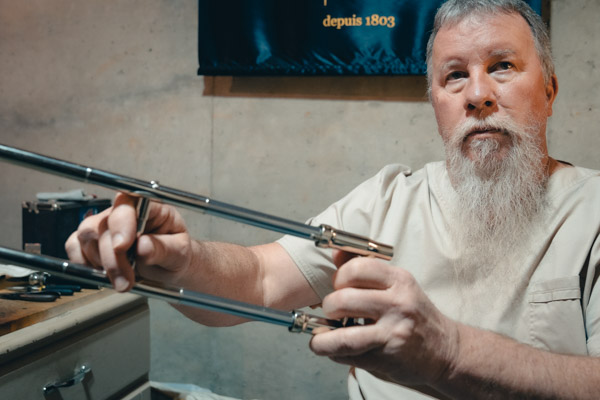Help for Sick Slides

& Good Ones Too…
~ How good is your slide?
~ How much do you know about how a terrific slide works?
The physics of a great slide are quite simple. For the slide to function at the highest possible level, it must:
- Have all four tubes perfectly straight, round and dent free
- Have the top and bottom outer tubes parallel on two planes, i.e., tubes the same distance from each other at the right hand grip and the crook, as well as parallel horizontally
- Have the inner slide tubes parallel horizontally
- Have each inner tube centered in its respective outer tube
- Have the stockings on the inner tubes parallel to the remainder of the tube
- Have an oxidation-free surface on the inside of the outer tubes
- Have the smoothest possible surface on the inside of the outer tubes
- Have the smallest possible amount of lubrication to do the job
In the past, players have expected the lubrication of the slide to eliminate this friction, but meet with only moderate success.
There are many factors that can contribute to friction. Oxidation, dirty tubes, imperfection in the tubes or geometry, are all contributing factors. To examine the current condition of your slide, try the following process.
To evaluate your current slide function:
Hold the slide by the left hand grip in a horizontal position, so that the slide crosses from left to right in front of your eyes.
Place your right hand inside the space between the outer tubes to be sure that you do not drop the outer slide during the test
Lower the 7th position end of the slide slowly while pivoting the left hand, keeping same height.
Watch to see how far the 7th position end of the slide must be lowered to cause gravity to move the slide out of 1st position
Watch to see if the slide moves at a consistent speed from 1st to 7th position.
If the crook end of the slide must be lowered more than 3 inches before the outer slide will move or if the slide stops or changes speed as it moves toward 7th position, then your slide will benefit from a setup by the Slide Doctor.

To determine how the pairs of tubes are operating, try the procedure outlined below.
Using one inner tube and the corresponding outer tube, hold the slide in a vertical position and introduce the inner tube slowly into the matching outer tube. If the inner tube goes in quietly and you feel no slowness or restriction, then repeat the process with the other pair of tubes. If either set does not work perfectly, you may have bent tubes, dents, on any of the inner or outer tubes, or oxidation on the inside of the outer tubes.
If the slide works well in pairs, but not so well when both pairs are used at the same time, then there may be a difference in the distances between the pairs of tubes. You may notice that the stocking ends of the inner tubes appear to be closer together or farther apart than the width of the outer slide at the open end, or it could be at the other end, near first position.
Carefully examine the location of the inside tubes (in a vertical position, with the outer slide about two inches (5cm) out of first position), you may detect that the inside tubes are not located in the center of the outside tubes.
One might expect that every new slide would come from the factory with these dimensions correct. In reality, it is not at all unusual for new slides to be close, but not exact. We all know that close only counts in the game of horseshoes and atomic bombs! This correction will require some soldering, which may burn the lacquer and may require spot lacquering.
Finally, if the slide was assembled (either when new or after a repair was made) without the use of a level stone, there is a high probability that the slide may be torqued. This condition can be found on both the inner and outer slide. First, picture the inner slide placed on a flat stone surface. When the slide is torqued, one tube will lay flat on the stone. The other tube will touch the stone at the handgrip end, but the stocking end will be raised up above the stone. The outer slide will look much the same, but can be rocked back and forth on the stone. To function properly, both sets of tubes must sit perfectly flat on the stone.
If any of the mechanical components have imperfections that cause friction, resulting in a sluggish slide that is neither smooth nor fast, then your slide will benefit from a setup by the Slide Doctor.
Disclaimer: The Slide Dr. will assume no responsibility for accidents caused by players who attempt to do their own repairs.
Testimonials
What People are Saying
“Highly Recommend”
"As a touring musician... I've had my slide aligned by some of the best technicians in the country... I would HIGHLY recommend the Slide Dr.'s services!"
Megan O
“Brilliant”
"Slide Dr. work is brilliant. I went to him a few years ago and will always continue to bring my slides. Very fair pricing and superior customer service makes the Slide Dr. stand above with his work."
Jordon S
“Absolute Magician”
"This man is an absolute magician. I destroyed my slide at a football game and took it to the Slide Dr the next morning. He fixed it better than it was new in no longer than two hours... Every trombone player should have the Slide Dr check out his/her slide. Absolutely recommended!"
Luis R
“Fantastic job”
"My slide was in terrible shape. It was slow and out of alignment. I sent my slide to the Dr. and it is a different slide. They did a fantastic job. I would definitely recommend them."
Jay W
Have a question?
Let's talk slides!

